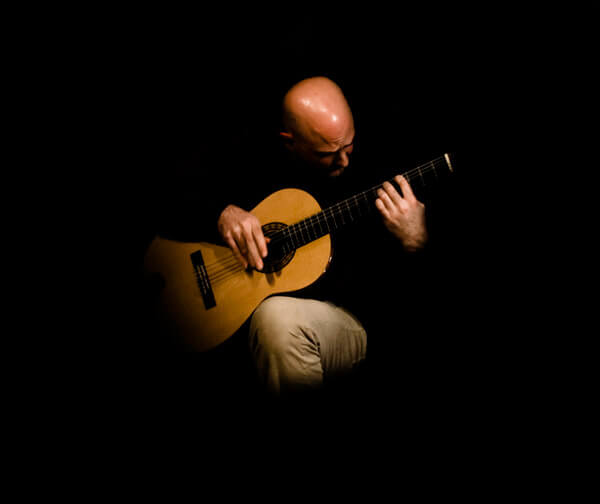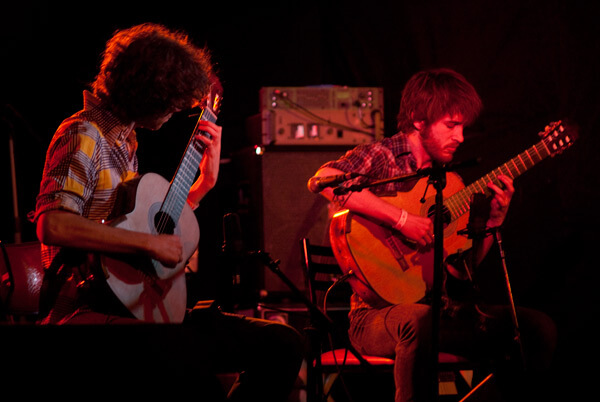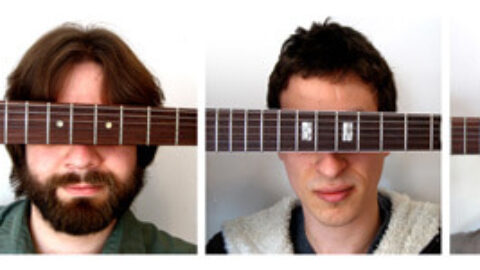 On January 26, I spent the evening at Le Poisson Rouge for a show called Indie-Classical Guitars: Music for 1,2,3 and 4 Guitars, tasked with providing an “indie rocker’s” perspective on this crossover-type event . My first reaction to the title was mixed. “Indie” and “Classical” are both somewhat loaded terms. After seeing the show, though, I think the title was an appropriate choice. The common ground among all four of the evening’s acts was a blending of classical and pop sensibilities. All the groups were relatively young and the pieces were mostly from up-and-coming composers (with one notable exception), or were composed by the artists themselves.
On January 26, I spent the evening at Le Poisson Rouge for a show called Indie-Classical Guitars: Music for 1,2,3 and 4 Guitars, tasked with providing an “indie rocker’s” perspective on this crossover-type event . My first reaction to the title was mixed. “Indie” and “Classical” are both somewhat loaded terms. After seeing the show, though, I think the title was an appropriate choice. The common ground among all four of the evening’s acts was a blending of classical and pop sensibilities. All the groups were relatively young and the pieces were mostly from up-and-coming composers (with one notable exception), or were composed by the artists themselves.
The night was arranged in ascending order by ensemble size and, as it turned out, decibel level. Andrew McKenna Lee came on first, armed with a nylon-stringed classical guitar. He didn’t introduce the pieces, but from a look around his website, I’m pretty sure he started with the first two movements of his three-movement Scordatura Suite.

Lee had the audience completely in his thrall within the first few measures: a fast-and-furious, largely-improvised display of technical dexterity that someone like McKenna Lee would call a warm-up and the rest of us would call, well, impossible. Underneath all the virtuosity, though, were thoughtfully interwoven melodic lines and a compelling harmonic sense. The use of a traditional Celtic tuning lent the first piece a folky feel, but there were hints of jazz and American blues, striking dissonance and percussive slaps to the body of the guitar. Nothing felt out of place.
After these two movements, Lee put down his classical guitar, reached for a Fender Stratocaster and introduced Steve Reich’s Electric Counterpoint. Plenty has been written about this seminal 1987 piece and I’m not going to repeat it except to say that the piece remains strikingly relevant today (an assertion that was proven consistently throughout the night). I’ve heard Pat Metheny’s Electric Counterpoint countless times through headphones so it was a treat to hear it live. Lee’s rendition was largely faithful to the original, but while Metheny kept his sound dry, Lee’s was enlivened by the brightness of a Strat through a tube amp. McKenna Lee is obviously comfortable with the piece and with his mastery of it.
If Andrew McKenna Lee represented the classical end of the spectrum, the next group, Threefifty Duo, was bringing the indie. Twenty-somethings Brett Parnell and Geremy Schulick wouldn’t look out of place in Brooklyn rock club, and for the most part, wouldn’t sound out of place there either. In my circles, their music would best be described as “post rock,” fitting neatly beside bands like Explosions in the Sky or Do Make Say Think. That is, if they were a full band. As a duo, they fit the tone of the evening well, especially coming right on the heels of Electric Counterpoint. Threefifty’s compositions are well-considered and intimate. It’s clear that these two have been playing together for some time. Watching them made me nostalgic for days when I would sit around the house with a friend and play until every chord change and dynamic shift was completely intuitive. Parnell and Schulick even press each others effects pedals. Visual accompaniment provided by video artist Jennifer Stock added another Brooklyn-approved touch.

Next up was Twi the Humble Feather (“Twi” rhymes with “cry”). These guys, too, were definitely more indie than classical. Normally a three-piece, Twi performed on Thursday as a duo (and didn’t explain the absence of the third member), both members playing acoustic guitars and singing. With their driving rhythms and chanting vocal harmonies, I’m tempted to compare them to Animal Collective. But where Animal Collective achieves their sound through sampling, Twi gets there with just fleet fingers on acoustic guitars. The metronomic perfection of the guitar playing forms a driving, insistent undercurrent. The music tumbles forward endlessly while voices appear and disappear on top of it. Unfortunately, I was distracted throughout the performance by the harsh tone of the piezoelectric pickups in one of the guitars. As a guitarist, I’ve always hated the sound of piezo pickups and this was no exception. Please just put a microphone in front of your guitar! (I know there are technical concerns with using a microphone, but I also know that the sound could have been more carefully tailored.)

The last group of the evening was Dither. An electric guitar four-piece with effects pedals and tube amps, these guys look almost as Brooklyn as Threefifty. But Dither plays Serious Music. They set up in pairs facing inward towards a rack of music stands, which they proceeded to study diligently throughout their set. Their diligence paid off on the more precise, Reich-derived selections–Jascha Narveson’s aptly named The Driving One, and The Garden of Cyrus by Eve Beglarian. Both of these performances were tightly controlled and tasteful. The group’s serious, seated dynamic was less effective in the more dissonant, noisy Entropion by Lisa Coons and was especially questionable on closer I Am the Loudest Voice You Have Ever Seen.
I grew up listening to Sonic Youth and to the generation of noise-rock bands inspired by them. so I’m comfortable with noise and I understand its potential. But noise in such a clinical setting—played by four seated men on a well-lit stage, staring at music stands—loses a lot of its impact. Moreover, the best noise is always contextualized in some way. In noise rock, a solid bass-line provides a harmonic backdrop so the listener can perceive (consciously or subconsciously) unexpected and compelling harmonies in a squall of feedback. A steady drum beat turns random attacks and pulsing tremolo into poly-rhythms. Lacking any context, The Loudest Voice… seemed more like a demonstration of the different types of noise a guitar is capable of making.
I came away from this show wondering why we need a distinction between indie rock and classical music. The best moments of the night came from artists who clearly couldn’t care less how they are categorized.
—
Evan is a Brooklyn-based guitarist. He is currently playing bass in the indie-pop outfit Diehard, as well as lead vocals/guitar in Brooklyn’s only Pixies cover band: The Shitty Pixies. He continues to work with long-time collaborator Carrie Baron on the folk duo Carrie and Evan.
























